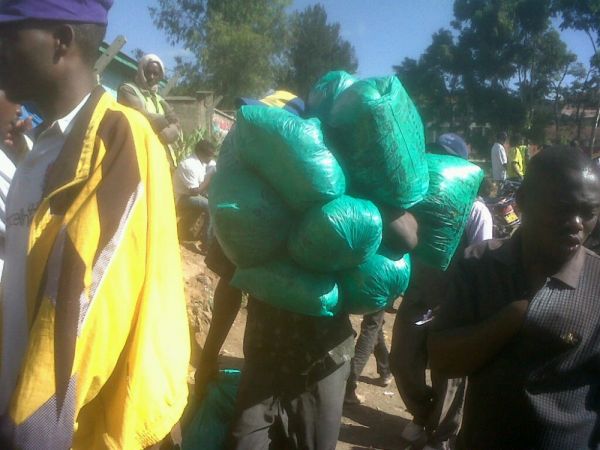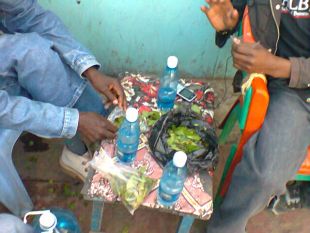Nairobi’s Legal Drug Dealers Take a Hit

Every day large bags of miraa are transported from the Kenyan countryside to a formal market in Nairobi, where they are sold to informal vendors. Photo credit: Sam Sturgis
“This is our office!” says Newton Murithi, surrounded by shanty hotels and informal restaurants. “It’s our lifeline, our economic backbone.” The middle-aged wholesaler of miraa points to a row of green bags, his wide grin revealing a set of teeth stained the same color, the smile of a man who clearly enjoys sampling his product as much as he enjoys selling it.
Along the Nairobi River, known primarily for the crimes that always seem to follow its stream, a number of formal miraa salesmen ply their trade. Appropriately named “Tsunami,” their large open-air wholesale market adjacent to the river receives a rush of industry traffic each day at 10 a.m. – transporters bringing in bundles of miraa from Kenya’s countryside, and informal vendors hauling their newly purchased bags out of the market and toward the city’s streets.
Miraa is a legal plant-based stimulant. It’s grown in Kenya’s Central and Eastern Provinces and makes up a crucial part of the national economy. Between 2006 and 2010, miraa was Kenya’s largest horticultural export in terms of value, bringing in over $188 million USD during those five years, with 90 percent of the exports going to neighboring Somalia. Following the Netherlands’ decision to ban the sale and import of miraa last month, protecting the stimulant’s export value has become a major issue in the run-up to next month’s presidential election.
But as is the case with many drugs, legal or illegal, the miraa economy seems to almost preternaturally drift toward informality.
“This market is very, very formal,” says George Karanja, a Nairobi City Council official, as he and his team frantically issue tax receipts to the transporters bringing miraa into Tsunami from rural Kenya. And he’s right: Wholesale vendors like Mr. Murithi are more than happy to pay the 30 shilling fee (35 cents USD) for each bag of miraa they bring into the market. In return, the regulated environment provides them with a steady stream of customers.

Buyers and sellers sort their product at Tsunami. Photo credit: Abdulrahman Abullahi
In the end, the tax-paying wholesale vendors typically walk with a daily profit of at least 1,500 shillings, or roughly $17 USD. “It’s providing for us,” Muritihi concludes, estimating that between the farmers, packers, transporters and city council officials, not to mention the restaurants and hotels operating within the market, “at least seven people benefit from the miraa before it reaches the street.”
For those who hawk miraa informally, however, the picture is starkly different. These street vendors – who go unaccounted for in the City Council’s receipts and export records – don’t have the luxury of an established, well-organized market from which to sell their product. Instead, they haul bags of the stimulant from the formal wholesale market into other neighborhoods, where it’s far harder to turn a healthy profit.
“I’m going directly to Eastleigh,” says Amina Muhammad while gathering the three green bags of miraa she purchased at Tsunami. For ten years Eastleigh, nicknamed “Little Mogadishu” for its large Somali population, was a major market for miraa providing Muhammad with enough money for food, school fees and cooking gas. But a decree issued by Kenya’s Department of Refugee Affairs in December stating that all urban refugees must relocate to refugee camps has exposed the vulnerability of informal miraa vendors like Muhammad. Without a stable income for her family, or a reliable flow of customers like the ones that pass through the Tsunami market, the new refugee policy has turned informal miraa trading into a struggle to just break even.
The decree is affecting even vendors who aren’t refugees themselves – Muhammad notes that many of her Somali clients in Eastleigh are now afraid to engage in the business at all, as buyers or sellers. “Business has been very down,” she says. “Sometimes I make losses, sometimes I make gains.”
“They [urban refugees in Eastleigh] are extremely active in the neighborhood’s economy,” says Melanie Teff, a Refugees International official, based in Nairobi. But many have fled the neighborhood, she adds, “because they can’t cope with the police harassment,” which has skyrocketed since the December decree. Now, informal miraa vendors find themselves stuck in a suddenly unprofitable business.
“I’m buying at 1,500 shillings and maybe selling at 1,500 shillings,” says Amina Dida, another Somali-Kenyan and informal miraa vendor. “Prices are high in the farm but low in the city.” With the Kenyan High Court deciding on February 4 whether Nairobi’s refugees will indeed be forced to vacate the city, informal miraa vendors like Amina Muhammad and Dida will be watching the decision closely. In the end, their livelihoods could depend on it.









